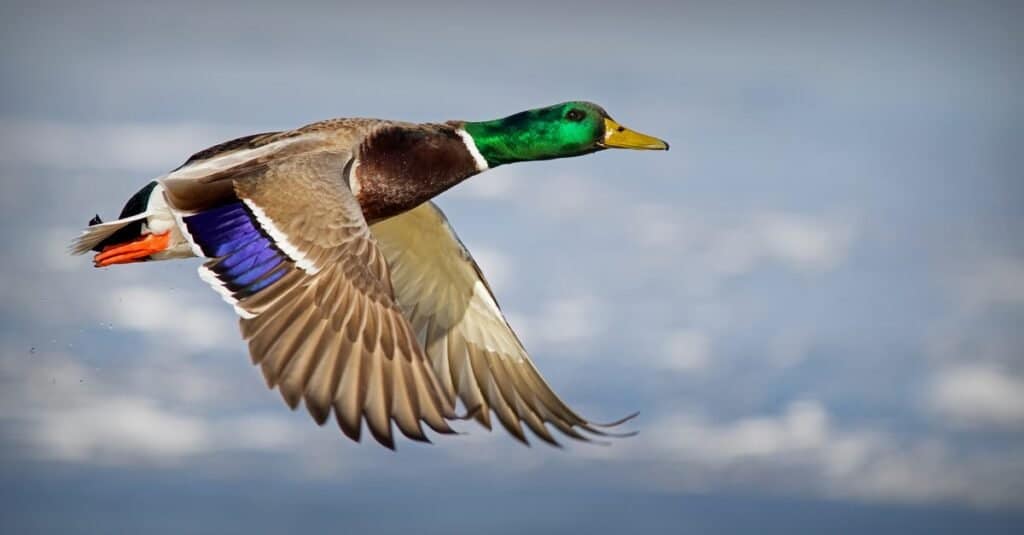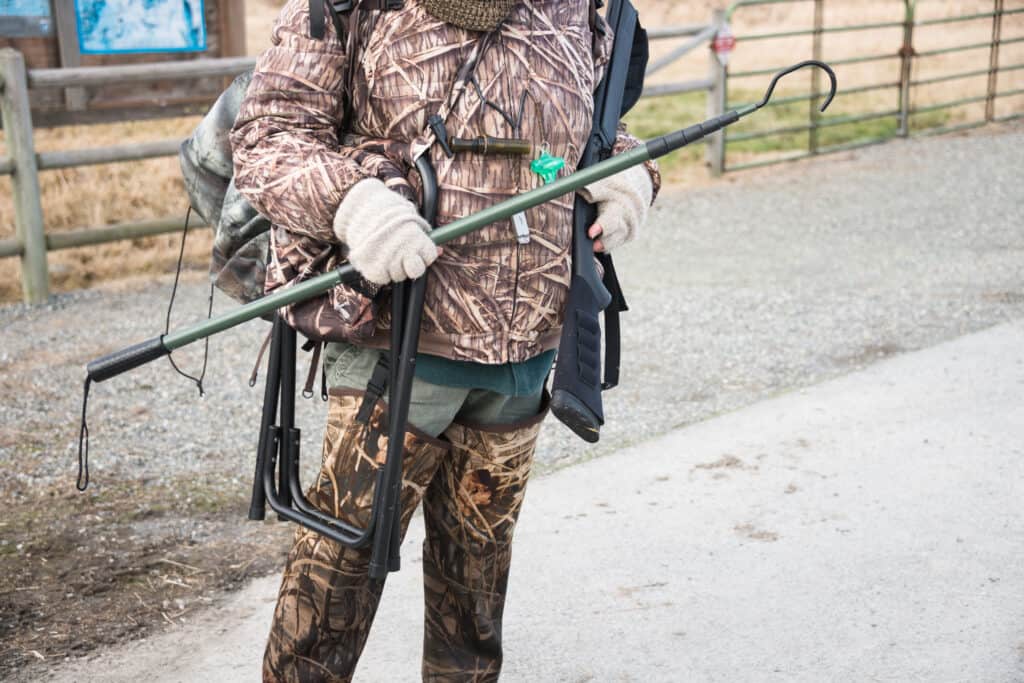When you think about ducks in New York you may picture a mama duck and her ducklings stopping traffic as they make their way to Central Park. But managing the duck population in the Atlantic Flyway provides opportunities for hunters to pitch in and duck hunt both along the coast and in state. Here, you can find out everything you need to know about duck hunting season in New York, including season dates, bag limits, and more!
What Kinds of Ducks are in New York?

Ducks migrating south for the winter will stop in New York on their way to the warmer southern states.
©Jeffry Weymier/Shutterstock.com
In New York, there is a wide range of duck species as well as waterfowl. Ducks migrating south for the winter will stop in New York on their way to the warmer southern states. Some of the most common duck species in New York include:
- Mallards
- Wood Duck
- Black Duck
- Blue-winged teals
- Green-winged teals
- Mergansers
- Hooded Mergansers
- American Wigeon
- Gadwalls
- Northern Pintail
- Sea ducks (scoter, eiders, and long-tailed)
Where can you Duck Hunt in New York?

Some of the popular locations to hunt ducks include Lake Champlain, Lake Erie and Ontario, the Finger Lakes, and along the Niagara River.
©iStock.com/CGreenePhotos
Check out this interactive map to find some of the best duck hunting in New York. Some of the popular locations include Lake Champlain, Lake Erie and Ontario, the Finger Lakes, and along the Niagara River. Suffolk County, Jefferson County, and Wayne County are the three top counties for the number of ducks harvested in New York over the past ten years.
What are the Hunting Zones in New York?
New York is divided into five zones: Western, Northeast, Lake Champlain, Southeast, and Long Island. These five zones have been approved by the U.S. Fish and Wildlife Service. Together with the New York State Department of Environmental Conservation, they manage the number of migratory ducks and waterfowl in the area.
Duck Hunting Season Dates in New York
| Species | Western | Northeast | Lake Champlain | Southeast | Long Island |
|---|---|---|---|---|---|
| Ducks | Oct. 15 – Nov. 6 Nov. 26 – Jan. 1 | Oct. 1 – Oct. 23 Oct. 29 – Dec. 4 | Oct. 15 – Oct. 23 Oct. 29 – Dec. 18 | Oct. 15 – Nov. 27 Dec. 3 – Dec. 18 | Nov. 19 – Nov. 27 Dec. 10 – Jan. 29 |
| Coots | Oct. 15 – Nov. 6 Nov. 26 – Jan. 1 | Oct. 1 – Oct. 23 Oct. 29 – Dec. 4 | Oct. 15 – Oct. 23 Oct. 29 – Dec. 18 | Oct. 15 – Nov. 27 Dec. 3 – Dec. 18 | Nov. 19 – Nov. 27 Dec. 10 – Jan. 29 |
| Mergansers | Oct. 15 – Nov. 6 Nov. 26 – Jan. 1 | Oct. 1 – Oct. 23 Oct. 29 – Dec. 4 | Oct. 15 – Oct. 23 Oct. 29 – Dec. 18 | Oct. 15 – Nov. 27 Dec. 3 – Dec. 18 | Nov. 19 – Nov. 27 Dec. 10 – Jan. 29 |
| Scaup | Dec. 13 – Jan. 1 | Nov. 15 – Dec. 4 | Oct. 15 – Oct 23 Oct. 29 – Nov. 7 | Nov. 24 – Nov 27 Dec. 3 – Dec. 18 | Jan 10 – Jan 29 |
| Snow Geese | Oct. 1 – Apr. 15 | Oct. 1 – Apr. 15 | Oct. 1 – Dec. 31 Jan. 16 – Apr. 15 | Oct. 1 – Apr. 15 | Nov. 24 – Mar. 10 |
| Brant | Oct. 1 – Nov. 19 | Oct. 1 – Nov. 19 | Oct. 15 – Dec. 3 | Oct. 1 – Nov. 19 | Nov. 19 – Nov. 27 Dec. 20 – Jan. 29 |
| Canada Goose Seasons | Check out this link to visit the season dates for the nine regions of goose hunting in New York |
Other Season Dates
| Western | Northeast | Lake Champlain | Southeast | Long Island | |
|---|---|---|---|---|---|
| Youth Days | Oct. 1 – Oct. 2 | Sept. 17 – Sept. 18 | Sept. 24 – Sept. 25 | Sept. 24 – Sept. 25 | Nov. 5 – Nov. 6 |
| Veteran and Active Military Days | Nov. 11 (Veteran’s Day) and Nov. 12 | Sept. 17 – Sept. 18 | No special season | Oct. 8 – Oct. 9 | Nov. 12 – Nov. 13 |
Bag Limits and Possession Limits for Duck Hunting in New York
The daily bag limit for ducks is six in New York. Note below the specifics on the combination of duck species, including sea ducks.
| Species | Bag Limits | Possession Limits |
|---|---|---|
| Ducks, Sea Ducks, and Mergansers | 6* | 18 |
| Coot | 15 | 45 |
| Scaup | 2 | 6 |
| Snow Geese | 25 | No limit |
| Brant | 2 | 6 |
| Canada Geese | variable | 3x the bag limit |
*Note: For ducks, here are the specific limits: “The daily limit of 6 ducks includes all mergansers and sea ducks (scoters, eiders, and long-tailed ducks) and may include no harlequin ducks and no more than 2 mallards (1 of which may be a hen), 3 wood ducks, 2 black duck, 1 pintail, 1 scaup (except 2 may be taken during the 20 days described in the seasons table), 2 redheads, 2 canvasback, or 4 total sea ducks (of which no more than 3 scoters, 3 eiders, or 3 long-tailed ducks). Of the 3 eiders, no more than 1 may be a hen. For all other duck species found in New York, the daily limit is 6.”
What are Shooting Hours?
The shooting hours in New York are ½ hour before sunrise to sunset. The exceptions include an extension on shooting to ½ hour after sunset for Canadian Goose in September (except for the Youth Weekend).
Gear Up! What Gear do you Need for Duck Hunting Season in New York?

Ducks can detect color, so wearing camouflage that matches your surroundings helps you stay undetected.
©Denise Lett/Shutterstock.com
Depending on the type of duck hunting, the location, and the weather, there are a few things you should have on hand to make your duck hunt successful. Duck hunting can be rather gear heavy, but after some experience, you will learn which items are essential and which items you can tweak or leave out. Here are some of the essentials most duck hunters recommend:
- Shotgun of choice, usually a 12 gauge or 20 gauge
- Gun case or bag to keep moisture away from your gun
- The right shells, 3” shells are the standard
- Duck blind or boat blind: Your blind makes a big difference in your success. There are a variety of choices, from shore-side blinds to decked-out boats. Some prefer to hunt from their kayak or canoe. Be sure to think about blending in with your surrounding, whichever boat/blind combination you choose.
- Life vest or PFD: For sea duck hunting or any hunting where you are in your boat, it is wise to wear a life jacket or PFD. Choose one that is comfortable, lightweight, and doesn’t interfere with your range of motion for shooting.
- Decoys: New Yorkers will certainly chime in about “the best” decoy spread, but you really need to find a spread that works best for your style. Usually, starting out with 12 decoys is a great way to lure ducks to your location.
- Camo: You want to blend in with your surroundings as much as possible. Ducks can detect color, so wearing camouflage that matches your surroundings helps you stay undetected. If you will be hunting in an area with lots of cattails and reeds, find a camo that matches that backdrop. You get the idea.
- Duck callers: Using a duck caller is an important skill for duck hunters. Be sure to practice before you get to your blind. There are many kinds and styles of callers and whistles. You may want to have a couple on a string or get a 6-1 whistle, so you are prepared for a variety of species. Remember that electronic callers are not allowed in New York.
- Waders: Whether you are offshore of Long Island or you are knee-deep in Lake Chamberlin, you are going to want to have a reliable pair of waders. They make them as a one-piece unit with the boots built-in, or you can buy waders with open feet and choose a custom-fit boot. Either way, think about the weather you will be hunting in so you can leave room for layers as the temps change.
- Dog (optional, of course): Hunting with your dog can be a rewarding event for both you and your dog. Watching them proudly retrieve your catch is worth all the training you went through. Common dog breeds used in hunting are Labs, Goldens, Pointers, and Spaniels. Be sure to pack gear for your dog as well, plenty of food, water, a leash for transitions, and a towel.
- Thermacell: If you are hunting earlier in the season, you will want a plan to deal with mosquitoes and other insects that enjoy warm moist conditions. Many hunters recommend a Thermacell to keep these pesky insects away.
- First Aid Kit: Duck hunting does have some dangers. While gun safety may be the first thing that comes to mind, hunting is actually statistically a very safe sport. It is more likely that minor mishaps like slipping on a muddy rock and twisting an ankle that requires an ice pack or a laceration requiring gauze and a Band-Aid. Having these items on hand makes it easier to tend to minor injuries on the water.
Factors for Success

Arrive early to your location to set up your decoys and still have plenty of time to get to your blind.
©iStock.com/Vershinin
Some of the most important factors to consider when duck hunting are your Blind, your decoys, and the weather for your hunt.
- Blind: Choosing the best location and the kind of blind is important. Remember to make it as camouflaged as possible. Follow the weekly migratory bird reports to see if the species you are targeting is on schedule.
- Decoy Spread: Experiment with different setups. Arrive early to your location to set up your decoys and still have plenty of time to get to your blind. Twelve decoys are probably enough for your first hunt. Then as you get more experienced you can change out and add more or less and change out the kind by adding bubblers or mojos as needed.
- Weather: Hunting in St. Lawrence or Jefferson County is going to be a tad chillier than the southern counties, especially in the later duck hunting season. Always dress in layers to adapt to the changing temps. Although you don’t have control over the weather, many duck hunters say that a cool, overcast morning may bring the best hunting.
Where are the Best Places to Duck Hunt in New York?

Lake Champlain is a popular hunting spot as well as along the shores of Lake Erie.
©Cassie Blaise-Metcalf/Shutterstock.com
On Long Island, there is a lottery to land a spot at some of the best hunting areas. You can hunt at Cedar Point County Park, Hubbard County Park, Montauk County Park, and Southaven County Park. Lake Champlain is a popular hunting spot as well as along the shores of Lake Erie.
Meet the Species: 3 of the Most Common Ducks in New York
- Mallards: Probably the most popular duck species around, the male mallards (drakes) have an emerald green head and a yellow bill. Their bodies are black and white with green tail feathers.
- Wood Duck: The Wood Duck is a bit flashy and has an iridescent green head with a red patched eye and orange behind its beak. The rest of their bodies are a mix of brown, black wings, and gray.
- Black Duck: They are not all black, but they have a dark brown body and a lighter head. The males have a yellow bill, and you can see a purple triangle on their wings when they are in flight.
New York Duck Hunting FAQ’s (Frequently Asked Questions)
Can you duck hunt in New York?
Yes, you can duck hunt in New York. Waterfowl hunters must have a hunting license, Federal Duck Stamp, and HIP certification.
When does duck hunting season start in New York?
Duck hunting starts Oct. 1 in the Northeast Zone of New York. Western, Lake Champlain, and Southeast can start on Oct. 15.
What are the most common ducks in New York?
The most common ducks hunted in New York are mallards, wood ducks, and black duck.
What is the bag limit for mallard ducks in New York?
The daily bag limit for mallard ducks is six.
How does New York rank in the country for duck harvest numbers?
New York is ranked 22nd in duck harvest (based on a 10-year average).
Up Next
- Discover the 10 Best National Parks in New York
- The 15 Biggest Lakes in New York
- Wood Duck vs Mallard Duck What are the Differences
The photo featured at the top of this post is © Wirestock Creators/Shutterstock.com
Sources
- Department of Environmental Conservation, Available here: https://www.dec.ny.gov/outdoor/28888.html
- Department of Environmental Conservation, Available here: https://www.dec.ny.gov/outdoor/103606.html
- Department of Environmental Conservation, Available here: https://www.dec.ny.gov/outdoor/71870.html
- Bird Watching HQ, Available here: https://birdwatchinghq.com/ducks-in-new-york/
Thank you for reading! Have some feedback for us? Contact the AZ Animals editorial team.






